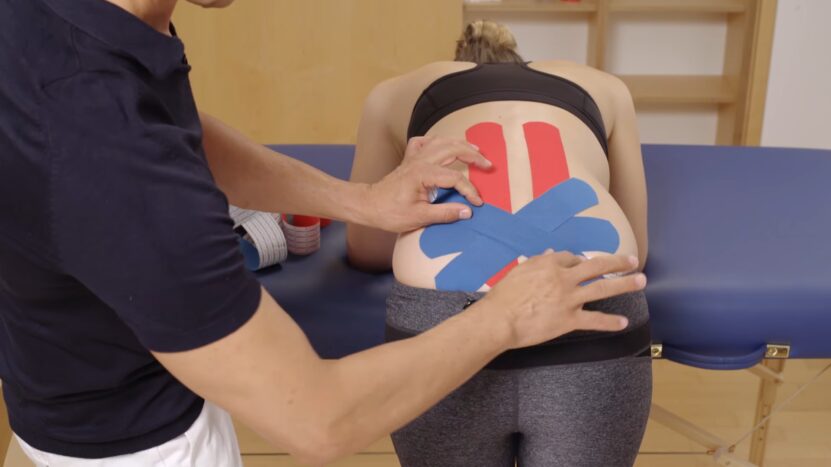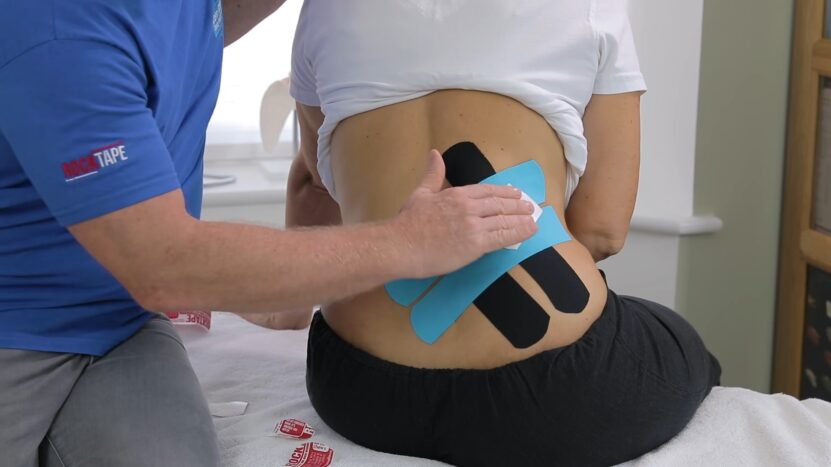Low back pain is a common and debilitating problem experienced by millions of people worldwide. It can negatively affect your daily life, work performance, and overall well-being. Conventional treatments, such as pain medication and physical therapy, may not always provide the desired relief. This is where kinesiology taping techniques come into play. It is a popular method used by athletes and active individuals to alleviate pain and support recovery. In this comprehensive guide, we will explore how kinesiology taping techniques can be used to effectively manage low back pain, helping you regain your life’s quality.
The Definition of Kinesiology Taping

Kinesiology taping is a therapeutic technique that involves the application of a special elastic adhesive tape to the skin. The tape, made of a cotton and nylon blend, is designed to mimic the elasticity and thickness of the human skin, allowing for a comfortable and non-restrictive range of motion. The primary goals of kinesiology taping are to:
- Provide support and stability to muscles and joints without restricting movement
- Reduce pain and inflammation
- Enhance circulation and lymphatic drainage, promoting healing
- Improve body awareness and proprioception, leading to better movement patterns and postural alignment
The Science Behind Kinesiology Taping
Kinesiology taping works on a few different levels. When the tape is applied to the skin, it gently lifts the skin and fascia (the connective tissue that surrounds muscles, blood vessels, and nerves), creating space for improved blood flow and lymphatic drainage. This can help reduce inflammation, alleviate pain, and accelerate the healing process.
In addition, kinesiology tape provides neuromuscular feedback that helps improve proprioception – the body’s awareness of its position in space. This can lead to better movement patterns, improved posture, and decreased strain on the muscles and joints, further reducing pain and preventing future injury.
Kinesiology Taping Techniques for Low Back Pain
Before we dive into the specific techniques, it’s important to note that kinesiology taping should be performed by a trained professional, such as a physical therapist, chiropractor, or certified kinesiology tape practitioner. They will assess your individual needs and determine the most effective taping technique for your condition. That said, there are several common kinesiology taping techniques used for low back pain relief:
Lumbar Support Technique
This technique is designed to provide support and stability to the lower back muscles, reducing pain and promoting proper posture.
- Begin by cutting a strip of kinesiology tape that is long enough to extend from the top of your buttocks to the lower ribcage.
- Apply the tape vertically along the spine, starting at the top of the buttocks and ending at the lower ribcage, with a gentle stretch.
- Rub the tape gently to activate the adhesive and ensure it sticks properly to the skin.
Decompression Technique
The decompression technique aims to alleviate pressure on the spinal discs and nerves, which can be a source of low back pain.
- Cut two strips of kinesiology tape, each approximately 10 inches long.
- With the patient in a seated position, bend forward slightly to create a stretch in the lower back.
- Apply the first strip horizontally across the most painful area of the low back, using a 75-100% stretch.
- Apply the second strip in the same manner, slightly overlapping the first strip.
- Return to an upright position and gently rub the tape to activate the adhesive.
Postural Correction Technique

Poor posture can contribute to low back pain by placing excessive strain on the muscles and ligaments. The postural correction technique aims to promote proper alignment and reduce pain.
- Cut two strips of kinesiology tape, each approximately 10 inches long.
- With the patient standing, locate the area of greatest postural deviation (typically, a rounded upper back and forward head posture).
- Apply the first strip vertically along the spine, starting at the lower back and ending at the upper back, using a 25-50% stretch. This will help encourage spinal extension.
- Apply the second strip horizontally across the shoulders, using a 50-75% stretch. This will help pull the shoulders back and promote proper alignment.
- Gently rub the tape to activate the adhesive and ensure it sticks properly to the skin.
Sacroiliac Joint Support Technique
Sacroiliac joint dysfunction is a common cause of low back pain. This technique aims to provide support and stability to the sacroiliac joint, reducing pain and inflammation.
- Cut two strips of kinesiology tape, each approximately 12 inches long.
- With the patient lying face down, locate the sacroiliac joint on one side (the bony prominence just below the lower back and above the buttock).
- Apply the first strip of tape diagonally across the sacroiliac joint, starting from the hip bone and ending at the opposite side of the lower back, using a 50-75% stretch.
- Apply the second strip in a similar manner, starting from the opposite hip bone and ending at the lower back, creating an “X” pattern over the sacroiliac joint.
- Gently rub the tape to activate the adhesive and ensure it sticks properly to the skin.
Safety Tips for Successful Kinesiology Taping
Kinesiology taping has gained popularity as a non-invasive, drug-free method to provide pain relief and support for a variety of musculoskeletal conditions, including low back pain. However, as with any therapeutic intervention, it is essential to take safety precautions to ensure a positive experience and minimize the risk of adverse effects.
1. Consult a Trained Professional
While kinesiology taping might seem simple, it is crucial to consult a trained professional, such as a physical therapist, chiropractor, or certified kinesiology tape practitioner, before attempting any taping techniques. These professionals can assess your individual needs and provide guidance on the most appropriate and effective taping methods for your specific condition.
2. Skin Preparation
Proper skin preparation is essential to ensure the tape adheres effectively and minimize the risk of skin irritation. Make sure the skin is clean, dry, and free of oils, lotions, or sweat before applying the tape. Trim any body hair in the area to be taped, as this can interfere with proper adhesion.
3. Allergy and Sensitivity Considerations
Some individuals may have sensitive skin or allergies to the adhesive used in kinesiology tape. If you are unsure about your skin’s reaction to the tape, perform a patch test by applying a small piece of tape to an inconspicuous area and monitoring for any signs of irritation or discomfort. If you experience itching, redness, or other adverse reactions, remove the tape immediately and consult a healthcare professional.

4. Proper Application
Incorrect application of kinesiology tape can lead to skin irritation or ineffectiveness of the treatment. Follow the guidance of your trained professional, and adhere to the recommended stretch levels, taping patterns, and techniques. Overstretching the tape or applying it too tightly can cause discomfort or restrict blood flow, while insufficient stretch may not provide the desired therapeutic effect.
5. Avoid Taping Over Wounds or Irritated Skin
Kinesiology tape should not be applied over open wounds, rashes, or irritated skin. Doing so can exacerbate the issue and may lead to infection or other complications. If you have a skin condition or wound in the area to be taped, consult a healthcare professional for guidance on appropriate treatment and management.
6. Duration of Wear and Removal
Kinesiology tape can typically be worn for 3-5 days, depending on the specific brand and your skin’s sensitivity. However, if you experience any discomfort, itching, or irritation, remove the tape immediately. When removing the tape, do so slowly and gently, in the direction of hair growth, to minimize the risk of skin irritation or hair pulling.
Final Words
Kinesiology taping techniques can provide effective relief for individuals suffering from low back pain. By providing support, reducing inflammation, and promoting proper alignment, kinesiology tape can help you manage pain and get back to the activities you love. Remember to always consult a trained professional before attempting any kinesiology taping techniques, and follow the tips provided for a successful application. Give kinesiology taping a try, and experience the benefits for yourself.

